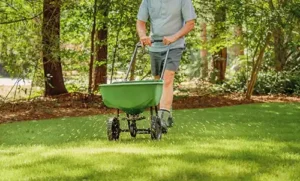Although fertilizing your lawn right after sowing seeds may seem like a good idea, it’s important to separate these two tasks. Newly sprouted grass is much more fragile than established turf, and fertilizer may be too potent for their early growth. Fertilizing during overseeding could cause problems like:

- Nutrient Competition: Seeding and fertilizing simultaneously can lead to competition between the new seeds and existing grass for available nutrients. This can make both processes less effective, possibly resulting in poor seed germination and stunted growth.
- Varying Nutrient Needs: Newly planted seeds require specific nutrients during germination and establishment, which may differ from the needs of established grass. Using a general fertilizer may not supply the right nutrients for the young seeds’ development.
- Disruption to Seeds: Fertilizing, whether with granules or liquid, can disturb the soil and displace newly sown seeds. This disruption can prevent proper seed establishment and hinder healthy growth.
Need Lawn Care? We Can Help.
Click the button below to leave your information & we'll be in touch in an hour or less.
Leave your information below and we’ll be in touch with a FREE quote!
"*" indicates required fields
*During normal business hours. After hours calls will be returned the next business day.
Should I Overseed Before or After Fertilizing My Lawn?
Overseeding and fertilizing are key steps in maintaining a healthy lawn. But to ensure new sprouts thrive, it’s essential to apply them in the proper sequence. For the best results, follow these guidelines:
- Aerate the Soil: Aerate the soil to improve seed-to-soil contact.
- Remove Thatch: Clear away any thick layers of thatch to help seeds penetrate the soil.
- Overseed: Spread the new seeds evenly across the lawn.
- Water the Grass Deeply: Ensure the soil is moistened thoroughly to help seeds germinate.
- Wait a Few Weeks: Give the seeds time to sprout and establish roots.
- Apply a Fertilizer Treatment: Once the grass is growing, apply a balanced fertilizer to encourage healthy growth.
Following this sequence will prepare the soil for new growth and help seeds germinate more easily. It also allows the grass to establish itself before introducing additional nutrients with fertilizer.
How Long Should I Wait Between Seeding and Fertilizing My Lawn?
The best time to fertilize your lawn after seeding is around six to eight weeks. Allowing the sprouts to establish before applying fertilizer minimizes the risk of damaging new growth and ensures they can properly absorb the nutrients, promoting a healthier lawn in the future. This also helps avoid over-fertilization, which can stress young grass and hinder its development.
Professional Lawn Overseeding Services
Overseeding your lawn involves multiple steps, including removing thatch and establishing a consistent watering schedule. To help your new grass grow strong and healthy, it’s a smart idea to consult a professional lawn care expert. Their expertise will ensure a beautiful, thriving lawn with less hassle.
If you’re looking for exceptional lawn care in Florida, contact the expert team at Bug Out! With over 60 years of experience serving both residential and commercial clients, we deliver lasting, outstanding results. Our comprehensive lawn care services will elevate your landscape.
